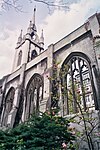St Mary-at-Hill

St Mary-at-Hill is an Anglican parish church in the Ward of Billingsgate, City of London. It is situated on Lovat Lane, a cobbled street off Eastcheap. It was founded in the 12th century as "St. Mary de Hull" or "St. Mary de la Hulle". It was severely damaged in the Great Fire of London in 1666. It was only partially rebuilt and has been much altered since, although some of its mediaeval fabric survives. The Church of St Mary-at-Hill is situated among some of the city's most ancient lanes: St Mary at Hill EC3, in which has a large double-faced clock extending several feet into the street and which provides the best view of the church's elegant exterior; a narrow alleyway running alongside, but with no right of way; and, its entrance on Lovat Lane EC3, its postal address.
Excerpt from the Wikipedia article St Mary-at-Hill (License: CC BY-SA 3.0, Authors, Images).St Mary-at-Hill
Lovat Lane, City of London
Geographical coordinates (GPS) Address External links Nearby Places Show on map
Geographical coordinates (GPS)
| Latitude | Longitude |
|---|---|
| N 51.510069 ° | E -0.08374 ° |
Address
St Mary-at-Hill
Lovat Lane
EC3R 8EB City of London
England, United Kingdom
Open on Google Maps











